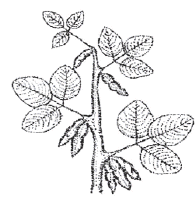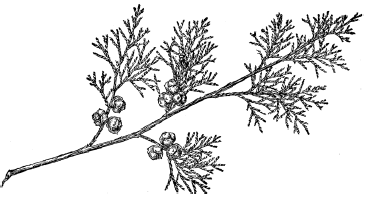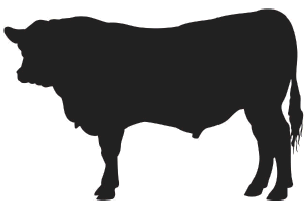

To send a message to an author, click on the author's name at the end of the article.
This Month in Ag Connection | Ag Connection - Other Issues Online
Soybean planting season in Missouri is here. Producers should be aware of soybean diseases such as sudden death syndrome (SDS) including: 1) the causes, 2) symptoms, and 3) management practices to minimize its effect in the crop growth and yield.
Sudden death syndrome of soybean is one of the most devastating soil-borne fungal diseases throughout the soybean growing areas of the USA, including Missouri. The crop damage and yield loss due to SDS depends on various factors such as weather, soybean variety, crop growth stage when foliage symptoms start to appear, presence of soybean cyst nematode (SCN), soil properties (soil fertility and pH), soil compaction, and drainage condition. In severe cases, SDS can result in soybean yield loss up to 80%.
Generally, disease symptoms start to appear on the foliage after flowering. The symptoms begin on upper leaves with yellow spots between leaf veins, known as interveinal chlorosis. Leaf issues in these spots may expand, turn brown and die between veins, called interveinal necrosis. Leaves may curl upward, while veins remain green. As disease severity increases, leaves die and fall prematurely from the plant; however, petioles remain attached to the stem. Pods and seeds may also drop. These foliar symptoms may be similar to other diseases as well; therefore, close examination of stem and root is very important for an accurate diagnosis. If the stem pith is brown and discolored, the disease might be brown stem rot rather than SDS. When soil is wet, the SDS fungus can reproduce on the root surface, sometimes producing a mass of spores which are purple to blue in color.
The SDS fungus overwinters in crop residue and soil. Factors which favor fungal infection of the soybean root include cool wet soil conditions a few days after seed germination.

There are several strategies to manage or minimize SDS. These strategies include:
Since SDS is a soil-borne fungal disease, foliar fungicide applications are not effective. Seed treatment with the fungicide fluopyram (ILeVO®, Bayer CropScience) is considered effective against SDS. Researchers have reported reductions in SDS severity by using ILeVO® treated seed in the North Central USA. The University of Missouri Strip Trial program has initiated on-farm trials comparing soybeans with or without ILeVO® seed treatment. For more information about participating in University of Missouri Strip Trials contact your extension agronomist or visit http://striptrial.missouri.edu/
Source: Dhruba Dhakal, Agronomy Specialist
This Month in Ag Connection | Ag Connection - Other Issues Online
The Eastern red cedar is typically not a tree considered for home landscapes, but is well adapted to Missouri soils and climate. The Eastern red cedar is a common tree found throughout most of the plains states and eastern U.S. along roadsides, in fence rows and scattered across fields, especially where limestone soils are present. It can be a weedy species and must be controlled in some areas.
The Eastern red cedar is native to North America. It is aromatic, with reddish colored wood giving off a distinctive scent. It is tolerant of heat, salt, a wide range of soils and other adverse conditions. Since they are quite salt-tolerant, they can be used near roads, driveways, and sidewalks. These cold hardy, adaptable evergreen trees serve many purposes in landscapes, especially in sites that are dry, alkaline or windy. The foliage of scale-like needles is attractive but prickly. The foliage may turn brown-green in winter. Improved cultivars of this species often retain better foliage color in winter. It is a dioecious species (separate male and female trees). Birds are attracted to the small, round, bluish-gray, berry-like fruits (modified cones), which are produced by female trees in the late summer and fall.

Eastern red cedar is usually a tree, but there are shrub-sized cultivars available. It can be used for windbreaks and in city landscapes for hedges, screens, clumps or even as specimen trees. Eastern red cedar is easily grown in average, dry to moist, well-drained soils in full sun. It tolerates a wide range of soils and growing conditions, from swamps to dry rocky glades. It prefers moist soils and is intolerant of constantly wet soils. It has the best drought resistance of any conifer native to the eastern United States. In Missouri, it typically occurs on limestone bluffs and glades, wood margins, fields, pastures and fencerows throughout the state except for the southeastern lowlands.
The Eastern red cedar has no serious insect or disease problems but is the host plant for cedar apple rust. Cedar apple rust is a common fungal disease on apple and crabapple trees which cause small galls (3/8 to 1 3/16 inches in diameter) to develop on the needles and twigs of the cedar tree. When mature, these galls swell considerably and repeatedly produce orange, gelatinous horns during rainy spring weather.
Cedar apple rust on apple, crabapple and other susceptible species appear as yellow spots on the leaves after infection in the spring. As the spots mature, they become yellow/orange and swollen with a red border and develop tiny black dots (spermagonia) in the center of the lesion.
Resistant varieties are available. Do not plant Eastern red cedar within a few hundred yards of susceptible plants. This will reduce, but not completely eliminate disease issues. Prune and remove brown woody galls found on cedars before orange gelatinous spore producing structures form in the spring to reduce the level of infection on nearby susceptible plants. Watch for bagworms on Eastern red cedar from late May to mid-June. At this time, bagworm larvae may begin emerging from 1-2 inch long diamond shaped bags, which are made from twigs and leaves. Pick off all bags and destroy them. (more information on bagworms see http://extension.missouri.edu/p/G7250)
There are several advantages and disadvantages of the Eastern red cedar, but it may be a viable landscape tree for some. For more information contact your local county extension office.
Source: Jennifer Schutter, Horticulture Specialist
This Month in Ag Connection | Ag Connection - Other Issues Online
In order to maintain a uniform calf crop annually, it is important to manage the postpartum interval, which is the time between when a cow or heifer has a calf until she returns to estrus (heat). During this time, she will be infertile due to several factors: uterine involution, suckling inhibition of hormones, and nutritional status.
Uterine involution is the first factor which must under-go correction. This involves restructuring and healing of the uterus back to its corrected shape and size. This process takes about three weeks after a normal birth.
Suckling of a calf inhibits hormones necessary for resumption of estrus. Several methods have been shown to shorten a female's postpartum interval, but should be done with caution so a calf's nutritional requirements are met. According to a study from Clemson University, once-daily suckling and early weaning methods reduced the postpartum interval by 12 and17 days, respectively, as compared to typical nursing. Another example from Texas A&M University showed a 99 day difference in postpartum interval between typical nursing and once-daily suckling methods. Although the length of postpartum interval has varied, this method has been proven to be effective.
Lactation is the most nutritionally demanding point in a female's life and can be the most difficult factor to overcome. It is crucial to meet a cow's or heifer's nutritional needs during this time. It is preferred to increase the available nutrients right before calving and maintain a higher plane of nutrition during early lactation. Cows should calve at a body condition score of 5 and heifers at a body condition score of 6 in order to get ahead of the likely loss in condition during lactation.
The length of a mature cow's postpartum interval can be shortened to about 60 days, while a heifer should be allowed an additional 30 days due to her added growth requirements. In order to keep a 365-day calving interval, a postpartum interval of approximately 80 to 85 days is ideal, based upon a 280-day gestation period. It is best to breed heifers about 30 days before the mature cows, due to their additional growth requirements.
Source: Anita Snell, Livestock Specialist
This Month in Ag Connection | Ag Connection - Other Issues Online
The 45th Annual Northeast MO Performance Tested Bull Sale was held at Palmyra, on March 25. The overall average on 47 bulls was $3,481.
The high breed average was Angus at $3,599. Other breed averages were Simmental $3,400, Polled Hereford $3,343, and Charolais $2,762.
High selling bulls in the sale were consigned by Double A Angus, Shelbyville; Keithley/Jackson, Frankford, and sold for $5,800 and $5,100 respectively. They were purchased by Palmer Farms New London, and Tim Floweree New London. Thirteen other bulls sold for $4,000 or higher.

Other top selling bulls included Ricketts Charolais, top Charolais at $3,250; Donald Drebes, top Simmental at $3,700.
Bulls offered in this sale met certain predetermined standards in order to be eligible for this sale. Bulls must be in the upper 50th percentile in two out of four EPD (Expected Progeny Difference) traits: CE or BW, WW, YW, or Milk, yearling height 49 in or above, weight at a year 1100 lbs. or above, semen tested and examined for breeding soundness and to be found satisfactory potential breeders. As well as meeting health requirements: tested and found negative for Brucellosis and BVD-PI, vaccinated against Leptospirosis, and must follow state requirements for trichomoniasis.
The annual meeting of the NEMO Beef Cattle Improvement Association, which sponsors the bull sale, was held March 30 in Hannibal. Awards were presented to the owners of the high indexing bulls in the sale. Charolais went to Ricketts Charolais, Angus went to Tony Griffin, and Hereford went to Clint Allen. Other awards presented, included Outstanding Seedstock Producer, Shon Haerr, Taylor; Outstanding Commercial Producer, David Clark, Edina; and Outstanding Service, Cindy Claus, Palmyra.
The sale is a cooperative effort between the NEMO Beef Cattle Improvement Association and University of Missouri Extension. For details on participating, contact your nearest Extension Livestock Specialist. The next sale will be March 31, 2018 at F & T Livestock Market, Palmyra.
Source: Daniel Mallory, Livestock Specialist
This Month in Ag Connection | Ag Connection - Other Issues Online
This past month AgEBB updated their front page to make it easier to find data. The site can be found agebb.missouri.edu This site has been online for years through the MU Ag Economics Department and goes to various MU agriculture websites.
The new design is based upon topics:
The MU weather stations can still be easily found under weather. Some new data that may be of interest is under Information Resources. The various "resource guides" have much information on the topic and species and worth browsing through to find the information most useful.
The Marketing heading includes the "Hay Market Listing". This may be of interest if you are looking to purchase hay or sell hay. If you have hay to sell, just register via email and the site allows the user to enter their own data and it will be viewable to anyone visiting the site. The best part is there is no fee to list it. Listings typically stay on the site for 60 days, but can always be relisted as well.
The heading Crop and Plant Resources includes MU Diagnostics Services. This includes links to all the MU diagnostics sites and the forms.
Source: Mary Sobba, Ag Business Specialist
Publishing Information
Ag Connection is published monthly for Northeast and Central areas of Missouri producers and is supported by the University of Missouri Extension, the Missouri Agricultural Experiment Station, and the MU College of Agriculture, Food and Natural Resources. Managing Editor: Mary Sobba.